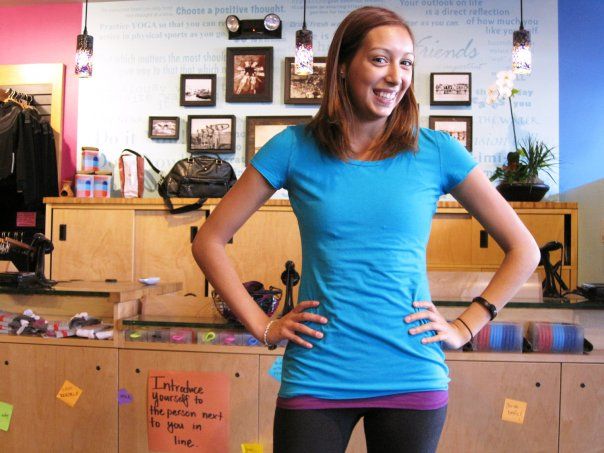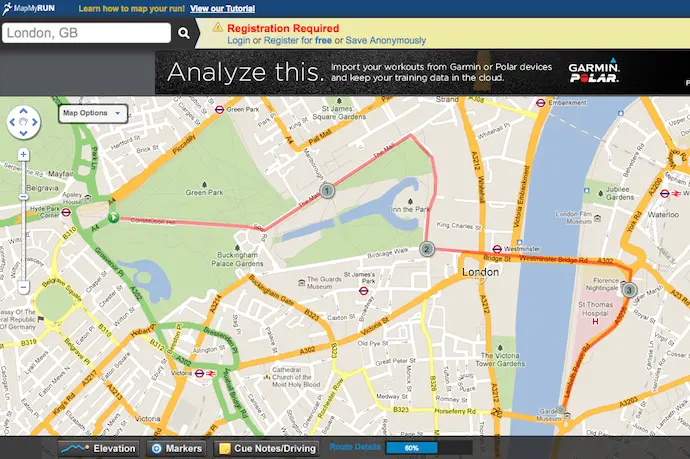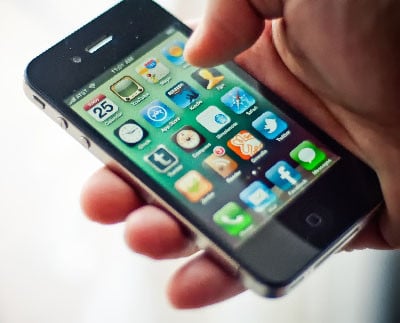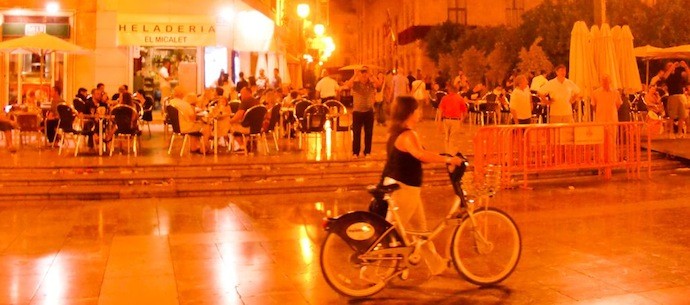
As we found out last week, human beings like all of us, are really terrible at estimating things (check out #5 on this list); with it get worse when we’re talking about ourselves. In short, our Paleolithic brains tend to convince us we’re right all the time and doing stuff – like burning calories – much more than we really are.
Fortunately our biology has some silicon allies that can accurately let us know how many calories we’ve actually burned wandering around Berlin so we don’t overindulge in schnitzel afterward.
 A Crash Course In How Calories Work
A Crash Course In How Calories Work
The (extremely) basic premise of calories is they are a measure of energy our bodies use to do things like walk, travel, and do silly dances when we get drunk. We get calories from food and drink, burning them away when we do anything. (And I mean anything – reading this post alone you’ll burn an average of 5 extra calories.) Assuming we’re good so far, there are some basic rules in how you burn:
- The more energy you exert, the more calories you burn.
- The more you weigh, the more calories you burn.
- The more athletic you are, the more you burn overall.
- Men burn about 10% more calories per activity and at rest that women.
- The older you are, the fewer calories you burn.
Keep in mind these are general rules to give you an idea of how it all works, in case you needed a brush up. I’ve probably given some nutritionists and doctors chest pains by oversimplifying this much so let’s move on to the calories you’ll burn sightseeing.
Map It Out
Have you ever sat down in a cafe after a few hours of sightseeing and exclaimed, “I must have walked 10 kilometers today!” (Afterword wolfing down 10 danishes?) Most of us have probably uttered something along those lines without realizing the walk wasn’t as nearly as far as we thought.
To get an idea of how much you’ve walked after-the-fact you can use Map My Run. You’ll need to create a free account for this tool, which lets you draw a trail on a Google Map mash-up, calculating the distance you’ve covered. Map My Run also has a mobile version (iPhone, Android, Blackberry) you can fire up while you’re actually walking. Another good option for calculating walking distances is Gmap-Pedometer. You can’t begin to accurately calculate how many calories you’ve burned if you don’t know how far you’ve really walked.

To make your sightseeing efforts more accurate, count the number of steps you climb and go down throughout the day, and jot them down somewhere.
 Use GPS For Sightseeing Precision
Use GPS For Sightseeing Precision
Using online maps can give you good estimates for distance covered, but a more accurate tool is probably something you already carry in your pocket. The free SportyPal available for iPhone, Android, and Blackberry turns your mobile phone into a pedometer, keeping track of distance covered, meters climbed, and the rate at which you do so. (Thanks TurkeysForLife for the recommendation.) [The aforementioned Map My Run mobile app does something similar, but doesn’t take full advantage of the built-in GPS in mobile devices with cell service deactivated.] Another in the free price range, Run Keeper (Android, iPhone) is another app to consider.
Of course, walking around with mobile phone isn’t always practical and in some places not the best idea to whip out. Serious traveling runners and walkers can take a look at the various nondescript GPS watches like the Garmin Forerunner 405 for accurate distance measurements.
Adding To All Up, With Bonuses
We now have three of the four key variables (pace, distance, and time) to calculate how many calories you’ve burned. The last thing you’ll need is your weight. Most online calorie counters will let you input only 2 of the 4 variables, and this calorie calculator from About.com is the most straightforward. (Unfortunately it’s English units only.)
The most accurate figure per kilometer or mile, assuming an average walking pace, is using either of these formulas:
- For calories burned per kilometer: Multiply 0.67 x [your body weight in kg]
- For calories burned per mile: Multiply 0.3 x [your body weight in lbs]

The key ingredient to this mix of course being the accurate measurement of how much you actually walked. Calculators based on time miss things like reading maps, toilet breaks, and other stops that can have us seriously overestimating the amount of time on our feet.
- I hope you kept track of the stairs I mentioned above, add .11 calories to your total for every stair up and .5 for every stair you walked down.
Finally, for a bit of travel workout boost, you can add approximately 34 calories for every 5 minutes you spend shivering in cold climates and potentially 50 calories spent walking in temperatures about 40c (~104F). And don’t forget that day pack if you’re carrying, add 10 calories per hour if it weighs 2.25kg (~5lbs).
Good For Your Waistline And Future Travel Planning
A good assessment of your steps can not only help you keep that cute belly of yours in check by not overcompensating with too many delicious calories but give you an idea of what you can realistically sight-see in a day. Most of us unconsciously do this, mapping out an entire city, only to end stopping halfway our route to eat, people watch, and relax. Chances are, by accurately tracking how much ground you cover in one day traveling, you’ll have a better sense of what you can see (and eat!) in future trips.
[photos by: lululemonathletica (top photo of woman in blue shirt)]










That’ll be me in Istanbul then; sightseeing and getting thinner at the same time while mapping my progress with Sporty Pal. Hmm, I’d better find out how many calories there are in a large Efes first. 🙂
Julia
…you don’t want to know! 😉
SparkPeople.com has a great map tracking tool, it will calculate calories burned for you if you have timed your trek. It will keep the info in there if you choose and you can chart your distances over time, along with calorie counts for the day. Never thought of using it for sight seeing, thanks for the heads up!
Every little bit counts, though I prefer distance-pace based calculations 😉
This rings so true for me. When I visited Australia a few years back, we walked all over the place, so i felt like i earned the right to eat and drink as much as I wanted at all times. I ended up gaining a good ten pounds before I returned to the states. I didn’t even attempt to do math; I just figured I had burned enough to do whatever I wanted.
The combination of good food, bigger portions, and overestimated exercise can be a tough one to burn off later! Hope you did though 🙂
Uh…yes…I did…LOL!
Always looking out for the health of my readers! 😛
Some great practical tips here. I dated a bit of a fitness fanatic while I was traveling last year and she was very gung ho on keeping track of our calories in vs calories out.
I personally use a program called RunKeeper for my GPS/mapping and it works a treat. Map My Run is also good if you’re looking for a free alternative.
I like the way Run Keeper keeps track of stats, good program and web interface as well 🙂